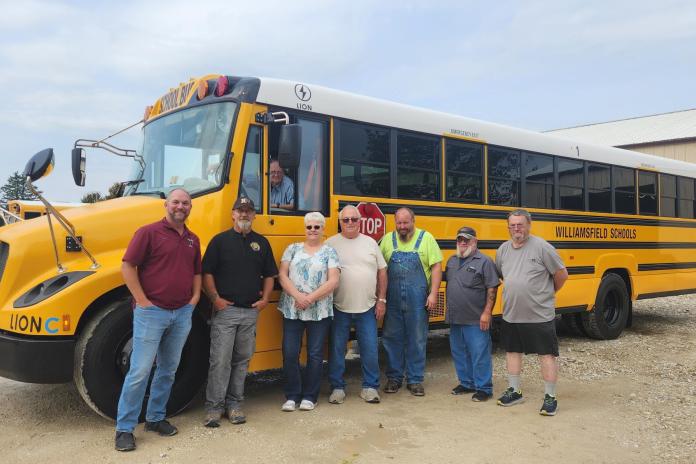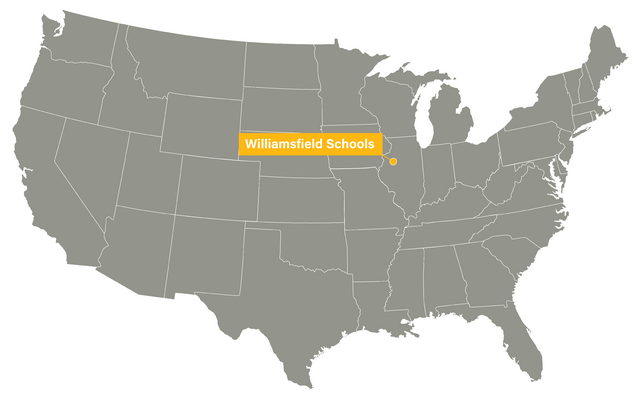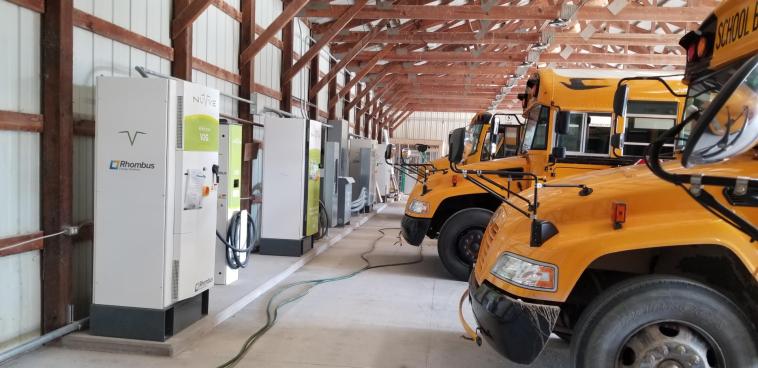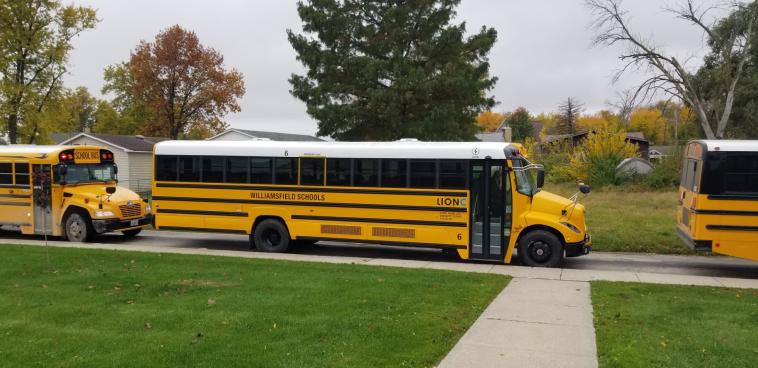How Students in a Rural Midwest District Led the Charge to Electrify and Boost Grid Resiliency
In Williamsfield, Illinois a student-led project to improve community resiliency helped the school district electrify its fleet and find tens of thousands of dollars in annual cost savings. Next up: using V2G technology to support community resiliency!

The Electric School Bus Series shows how superintendents and fleet managers across the United States have pursued school bus electrification in their own communities. This edition covers Williamsfield Schools, a rural district in Illinois where students have led the way in the successful adoption of electric school buses. This article is based off an interview with Tim Farquer, Superintendent of Williamsfield School District.
Williamsfield Schools | |
|---|---|
| Location | Williamsfield, IL (near Peoria, IL) |
| Number of students | 300 students |
| Number of schools | 3 schools, 1 campus |
| Percentage of students who ride the bus | 45% school transportation ridership |
| Fleet size | 9 total school buses |
| Number of electric school buses in fleet | 8 electric school buses. 5 daily electric school buses, 1 diesel-burning school bus used for longer routes. |
 | |
Since November 2023, Williamsfield Schools — a district with about 300 students just west of Peoria, Illinois — has operated an all-electric school bus fleet on its daily routes, with eight electric school buses (ESBs) total, thanks largely to a student-led process spurred in response to grid resiliency issues in the community. Williamsfield has continued to involve students in the school bus electrification process, including by integrating ESBs into courses and student activities. By transitioning to ESBs, Williamsfield is delivering health benefits to students and drivers, cost savings to the district, and working toward adding resiliency benefits to the broader community.
Why Williamsfield Schools chose electric school buses
Williamsfield’s interest in ESBs started around 2016 as a potential technology response to grid resiliency issues in the area. At the time, central Illinois was experiencing frequent power outages during extreme cold stretches in the winter months. After a particularly bad event when the district lost power, students designed a concept for a microgrid — a small, controllable power system that can be operated independently and continue providing power when the grid goes down — which they then presented to stakeholders on multiple occasions. Williamsfield Superintendent Tim Farquer and two students from the STEM course traveled to Chicago where the solar portion of their project was selected for funding through the Adjustable Block Program Lottery administered by Energy Solutions and funded through the Illinois Power Agency.
This funding allowed the district to turn the students’ proposal into reality and build the beginnings of a campus microgrid with on-site solar power in 2020. Since then, the district has continued to expand its microgrid, using ESB batteries and charging infrastructure for energy storage, and is working this summer to provide power to the school buildings to relieve congestion and save costs during peak demand.
Transitioning to ESBs has resulted in 94% cost savings for the district compared to diesel-burning school buses, saving the district over $30,000 annually.
By utilizing vehicle-to-grid technology, Williamsfield is working to turn its batteries into energy assets at times when they are not operating routes, which is most of the time — in fact, Farquer estimates that the school buses are only operating about 7% of the calendar year. When the electric school buses are not in use, Williamsfield will use the batteries to deliver power back to the school, supporting the schools’ overall operations while further reducing costs, especially at times of peak energy demand.
The energy and resiliency benefits of Williamsfield’s eight ESBs also extend beyond the school district into the broader community. Williamsfield is finalizing the process of entering into a mutual aid agreement with Knox County to allow the county to use the electric school buses as a source of back-up power when the grid is down, boosting energy reliability for neighboring communities and limiting the detrimental impacts of blackouts.
In addition to increased grid resiliency, Farquer emphasizes that ESBs provide a cleaner and more comfortable experience for students and drivers. Unlike diesel-burning school buses which produce harmful emissions, ESBs have no tailpipe emissions, delivering cleaner air for the community.

Partners and advocates
In 2022, Williamsfield received funding through the EPA’s Clean School Bus Rebate program, enabling the district to purchase seven Type C Lion Electric school buses. Since then, Williamsfield has purchased a “transformed bus” – also known as a repowered electric school bus – through Midwest Transit’s partnership with SEA Electric. Its repowered electric school bus is a bus that has had its diesel engine replaced by an electric motor and batteries.
Five of the district’s electric school buses are used on daily routes, one is used for student athletic events and one is used for transporting students to other after-school activities. Williamsfield worked collaboratively with partners to launch its project, including with an IBEW contractor, its utility (AmerenIL), and Nuuve and BorgWarner for the V2G charging infrastructure. Lion Electric also provided training materials for the drivers and mechanics.
Farquer said that the ESBs have driven exceptionally in winter weather and outperformed its diesel-burning counterparts in the cold.
Students played a critical role in supporting the electrification process beginning with their concept for a campus microgrid in 2016, and Williamsfield has since built out a student engagement component that fits in with the electrification.
For example, in a broadcast journalism course, students can do a video report discussing the transition to ESBs and in a statistics course students can support data analysis related to emissions reduction. Farquer notes that the transportation director and drivers have also been very supportive throughout the electrification process, and he has been impressed by how his drivers handled the transition to new school buses in the middle of the school year.

What’s the latest?
According to Farquer, Williamsfield’s electrification process has gone smoothly, and all daily routes have been operated by ESBs since November 1, 2023. Despite frequent sub-freezing temperatures in the winter months, Farquer says Williamsfield’s ESBs have performed flawlessly in cold weather and have even outperformed diesel-burning school buses from neighboring districts. Williamsfield uses diesel auxiliary heaters to maintain a comfortable cabin temperature on particularly cold days.
While the ESBs do require slightly more electricity in cold weather, they have not had any issues meeting range requirements, including the district’s longest route which is 40 miles long. Transitioning to ESBs has resulted in significant cost savings for the district, as Farquer estimates that electricity for ESBs is 94% cheaper than diesel, delivering $6,500 in annual savings per school bus. These cost savings are allowing the district to spend less on transportation and more on curricular opportunities for students.
Advice for other school districts
Farquer believes that involving students in the early stages of electrification contributed to the success of Williamsfield’s ESB program, as students are the strongest possible advocates for electrification because they experience the benefits directly. Across the country, students have leveraged their power and supported electrification in other districts, including through the Citizens’ Climate Lobby’s Great School Electrification Challenge.
He also emphasizes the importance of learning from other districts that have gone through electrification to see what has worked well and what could be improved upon. He encourages districts considering electrification to apply for funding while it is available and to not let the perfect be the enemy of the good. Thanks to federal funding, Williamsfield has transitioned in an entirely budget-neutral manner, while delivering additional cost savings and improving community resiliency.